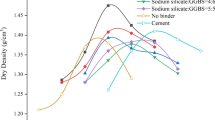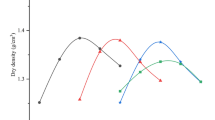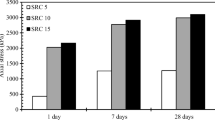Abstract
In recent years, several studies have been conducted on the stabilization of sulfate bearing soils treated with ground granulated blast furnace slag (GGBFS), as a partial substitution for calcium-based stabilizers (mainly cement and lime). The treatment of sulfate bearing soils using only slag cement has not been evaluated. In this research, the effectiveness of treatment of sulfate bearing soil with slag cement alone was evaluated through investigating the mineral formation and the rate of hydration of slag cement by XRD analysis. The prepared sulfate bearing subgrade soil specimens (containing 5030 ppm sulfate content) treated with the 3, 5, and 7% of slag cement were investigated after moist curing for 7 and 28 days. The XRD analysis results indicate that there was no mineral formation in the specimens cured for 7 days. However, after curing for 28 days, both the formation of ettringite and calcite minerals have been observed. Gypsum, the soluble sulfate source in native soil samples, was not detected in the samples treated with 7% slag cement stabilized soil. The results indicate that curing period and percentage of slag cement contributed to the ettringite formation in the slag cement treated sulfate bearing soil.
Access provided by Autonomous University of Puebla. Download conference paper PDF
Similar content being viewed by others
Keywords
1 Introduction
Calcium-based stabilizers (mainly lime and cement) have been utilized to stabilize subgrade soils for several decades now for increasing the strength, reducing the plastic index, aggregating the soil particles, and so forth [1, 2]. However, the soil will expand after the addition of the lime in the presence of soluble sulfate. The high content of calcium in lime releases the aluminum in the soil-lime mixture. The available calcium and aluminum interact with the sulfate in the solution, producing a swelling mineral, ettringite [3]. This phenomenon is referred to as sulfate-induced heave in geotechnical engineering practice [4]. To solve this problem, the applications of different types of stabilizers to treat the sulfate bearing soils have been introduced. The partial substitution of lime with slag cement can reduce the swell of sulfate-containing soil based on reducing the amount of calcium oxide (CaO) in the chemical stabilizer [5].
Slag cement is a by-product of the steel or iron manufacturing process, and thus, it is also named as “Steel Slag” or “Iron Slag” in the literature as well. Slag cement is a hydraulic cement after granulated blast furnace slag (GGBS) is ground to suitable fineness. In the construction industry, the slag cement is used to replace a portion of Portland cement to enhance the strength and durability and provide protection against sulfate attack [5]. Researchers in geotechnical engineering substitute partially the lime with slag cement to reduce the sulfate-induced heave. Wild et al. [6] stabilized sulfate bearing clay soils by partial substitution of lime with slag cement. The swelling associated with ettringite formation was decreased with the addition of slag cement. Harris used different stabilizers including acid, emulsion, enzyme, polymer, lignosulfonate, slag cement, and fly ash to treat soil with more than 20,000 ppm concentration soluble sulfate in Texas and found the minimum swell was the soil treated by 5% slag cement mixed with 1% lime. The addition of 6% lime into sulfate bearing soil resulted in nearly 40% swell, while the use of 5% slag cement + 1% lime suppressed the swell to 8% [7]. Celik and Nalbantoglu [8] evaluated the effect of slag cement on expansive properties of lime treated sulfate holding soils in North Cyprus. In the presence of 6% slag, the swell potential of the lime-treated soil with 10,000 ppm sulfate concentration decreased from 8 to 1%, whereas the lime-treated soil with 5000 ppm sulfate concentration showed no swelling.
The treatment of sulfate bearing soil using only slag cement has not been reported in the literature. Since it is an industry by-product, slag cement is more affordable than lime and cement. The utilization of the slag cement can reduce the construction costs if no expansion issue arises when enhancing the strength of the soil with slag cement. Therefore, it is necessary to determine whether the slag cement can mitigate the swelling of the sulfate-containing soils. To achieve this goal, the investigation of the ettringite formation is important. Also, whether slag cement, like lime and cement, would induce ettringite production. This study focuses on resolving this question and uses X-ray diffraction (XRD) analysis to evaluate the production of ettringite in the sulfate bearing soil treated by 3, 5, and 7% slag cement.
2 Methods
Initially, the soluble sulfate content of the native soils from Oklahoma is determined following the Oklahoma Department of Transportation (ODOT) OHD L-49: Method of test for determining soluble sulfate content in soil [9]. The basic geotechnical properties of the native soils, i.e., grain size distribution, Atterberg limits, the optimum water content, and maximum dry density are measured following the ASTM standards. The mineral composition of native soils and that of slag cement treated soil is obtained by X-ray diffraction (XRD) analysis. The chemical composition of slag cement is investigated using X-ray fluorescence (XRF) analysis.
2.1 Test Sample Preparation
The native soil after passing sieve No. 40 (0.425 mm), and mixing it well, was divided into three parts. Each part of the soil was mixed separately with 3, 5, and 7% by weight of dry slag cement, mixing the dry particles thoroughly, adding water above the soil’s liquid limit value. To ensure adequate water to complete the chemical reactions, the water content (above the value of liquid limit) of the mixture was brought to 30%. After stirring the mixtures thoroughly, the slurry state specimens were put into plastic cups, and the cups were sealed in plastic bags to avoid any moisture loss. All the sealed specimens were placed in an ice chest for curing 7 days at room temperature (22 ℃). The sample preparation procedure described above was followed for the specimens cured for 28 days as well. After the curing period, specimens were removed from the ice chest and sealed bags for air drying at the room temperature and crushed into fine powder and thoroughly mixed before the XRD analysis. The details of the testing program for XRD are shown in Table 1.
2.2 X-ray diffraction
X-ray diffraction is still the primary method used today for identifying minerals in fine-grained soils because different minerals have unique spacings of interatomic planes (i.e., d-spacings) [10, 11]. The XRD results provide the position of diffraction peak (i.e., 2θ angles). The d-spacings within the crystal lattice can be calculated from 2θ angles, allowing for mineral identification. The value of d-spacings correspond to the 2θ angle can be calculated according to Bragg’s law,
where the value of l would be any whole number.
When l = 1, the reflection is referred to as the first-order reflection, l = 2 corresponds to second order reflection, and so on. When identifying minerals, all series of reflections should be considered in case some of the reflection beams are interfered [10]. In fact, the second order reflection and next order reflection might not be shown in the diagram because of the limitation of the range of 2θ angles. Therefore, the value of 2θ angles or the d-spacings from the first-order reflection (i.e., l = 1) should be prioritized to identify the mineral [10].
For this study, the XRD analysis was performed in the Oklahoma State University Microscopy Laboratory, Stillwater, Oklahoma. The X-ray diffractometer is Bruker D8 Advance (Cu Ka radiation with 1.5406 Å of wavelength) run at 40 kV/40 mA with Lynxeye detector. The identification analysis was performed based on the Joint Committee on Powder Diffraction Standards, and American Society for Testing Materials-Mineral Powder Diffraction File: Search Manual (JCPSD) [12]. The data were utilized to identify the minerals in this study are displayed in Table 2, and the identification procedure is summarized as follows [12]:
-
1.
Calculated d-spacings correspond to the 2θ provided by the XRD diagram.
-
2.
Used the calculated value of d-spacings to locate the mineral in the JCPSD file to achieve the preliminary identification.
-
3.
The second order reflection and third order reflection were considered to achieve the final identification.
3 Material
3.1 Soil
Native soil was sampled in Woodward, Oklahoma, close to US Highway 412. After drying the sample in room temperature and removing the plant residues, the soil was crushed into smaller size for sample preparation and laboratory testing. The processed soil was tested for soluble sulfate concentration following the OHD L-49 method [9]. Engineering properties of the soil were investigated following the corresponding ASTM standard test methods [13,14,15]. The mineral components in the soil were obtained by X-ray diffraction (XRD) analysis. The information on soluble sulfate concentration, physical soil properties are listed in Table 3, whereas mineral compounds are listed in Table 4.
The soluble sulfate concentration is 5030 ppm, which is high enough to achieve the level for triggering sulfate-induced heave [16]. According to the investigation of engineering properties of the native soil, the soil was classified as ML. Five non-clay minerals were identified in the native soil, and the clay minerals, kaolinite, illite, and halloysite were detected after XRD analysis. Gypsum, a soluble sulfate mineral, was found in the native soil samples.
3.2 Slag Cement
The slag cement used in this study is supplied by the local branch of of Skyway Cement Company in Tulsa, Oklahoma. The chemical composition of the slag cement was determined using X-ray fluorescence (XRF) analysis as depicted in Table 5.
4 Results
The XRD test results for the specimens cured for 7 days present that there are no changes in the XRD pattern diagram (shown in Fig. 1) as compared to the XRD diagram obtained for the native soil. However, after the specimens are cured for 28 days, changes in the XRD diagram are observed as depicted in Fig. 2. This indicates that the longer curing period promoted the mineral formation from the samples of the slag cement and sulfate bearing soil mixtures. In other words, the slag cement hydration had not taken place within the 7 days of the curing period. For the specimens cured for 28 days, the formation of ettringite was detected, indicating that the reactions between the calcium, alumina, silica, and sulfate require longer curing time for ettringite precipitation. The production of calcite was also detected in the specimens cured for 28 days with 5 and 7% slag cement contents. The formation of calcite was probably due to the exposure of the mixtures to air in the laboratory. After curing for 28 days, gypsum was detected in the specimens treated with 3 and 5% slag cement, whereas there was no gypsum in the specimen stabilized with 7% slag cement. This probably means the higher percentage (7%) of slag cement depleted all the soluble sulfate in the specimen during hydration.
5 Discussions
The result from the XRD analysis for mineral identification in the sulfate bearing soil stabilized with slag cement demonstrates that the ettringite mineral has formed, and the rate of slag cement hydration was slow. The increase in the amount of slag cement also promoted ettringite formation. Those observations are attributed to the following reasons:
-
1.
The ettringite is generated during the reaction between sulfate and alumina in the presence of calcium [3]. The calcium, alumina supplied by hydrated slag cement and dissolved clay minerals, kaolinite and halloysite, reacted with the gypsum to produce the ettringite.
-
2.
Unlike in lime, the proportion of \({\text{CaO}}\) in slag cement is smaller resulting in the lower concentration of \({\text{Ca}}\left( {{\text{OH}}} \right)_{2}\) generated by the reaction between \({\text{CaO}}\) and water. Afterward, lesser amounts of \({\text{OH}}^{ - }\) ion are released during the ionization process of \({\text{Ca}}\left( {{\text{OH}}} \right)_{2}\). A high concentration of \({\text{OH}}^{ - }\) ion is commonly known as an activator in the process of slag cement stabilization to break the bond between \({\text{Ca}} - {\text{O}}\) and \({\text{Al}} - {\text{O}}\). Thus, in this study, the concentration of \({\text{OH}}^{ - }\) ion was insufficient to improve the rate hydration of slag cement.
-
3.
The \({\text{OH}}^{ - }\) ion also can release the \({\text{Al}}^{3 + }\) from slag cement and clay minerals to produce the \({\text{Al}}\left( {{\text{OH}}} \right)_{4}^{ - }\) molecule which combined with the \({\text{OH}}^{ - }\) ion and dissolved gypsum to induce ettringite formation [17]. The increase in percentage of slag cement raised the concentration of \({\text{OH}}^{ - }\) ion, causing more gypsum to dissolve to form ettringite. In this study, when percentage of slag cement increased to 7%, all the gypsum was dissolved and utilized in the ettringite formation (shown in Fig. 2). Thus, the percentage of slag cement also plays an important effect on the ettringite formation.
6 Conclusions
The main points of this study in the investigation of mineral formation in the soils treated by slag cement through XRD analysis are summarized as follows:
-
1.
The formation of ettringite and calcite has occurred from dissolution of gypsum when stabilizing sulfate bearing soil with slag cement.
-
2.
The rate of slag cement hydration is slow.
-
3.
The percentage of slag cement is important in the formation of minerals.
7 Recommendations
The relation between the amount of ettringite formed in sulfate bearing soil stabilized with slag cement and the amount of soil swelling was not investigated in this study. Therefore, a quantitative analysis of ettringite formation using XRD analysis and the volume change of slag cement treated sulfate bearing soil should be investigated in further studies.
References
Diamond S, Kinter EB (1965) Mechanisms of soil-lime stabilization. Highway Res Rec 92:83–102
Thompson MR (1966) Lime reactivity of Illinois soils. J Soil Mech Found Div 92(5):67–92
Rajasekaran G (2005) Sulphate attack and ettringite formation in the lime and cement stabilized marine clays. Ocean Eng 32(8–9):1133–1159
Adams AG et al (2008) Sulfate induced heave in Oklahoma soils due to lime stabilization. Geotechnical Special Publication
Higgins D (2005) Soil stabilisation with ground granulated blastfurnace slag, pp 1–15
Wild S et al (1999) Suppression of swelling associated with ettringite formation in lime stabilized sulphate bearing clay soils by partial substitution of lime with ground granulated blastfurnace slag (GGBS). Eng Geol 51(4):257–277
Harris P et al (2006) Recommendations for stabilization of high-sulfate soils in Texas, in Transportation Research Record, pp 71–79
Celik E, Nalbantoglu Z (2013) Effects of ground granulated blastfurnace slag (GGBS) on the swelling properties of lime-stabilized sulfate-bearing soils. Eng Geol 163:20–25
DOT O (2005) OHD L-49: method of test for determining soluble sulfate content in soil
Moore DM, Reynolds RC (1989) X-ray diffraction and the identification and analysis of clay minerals, vol 322. Oxford University Press, Oxford
Mitchell JK, Soga K (2005) Fundamentals of soil behavior, vol 3. John Wiley & Sons Hoboken, NJ
Joint Committee on Powder Diffraction Standards, a.A.S.f.T.M. (1980) Mineral powder diffraction file search manual: chemical name, Hanawalt, Fink, Mineral Name. JCPDS
Standard Test Method for Particle-Size Distribution (Gradation) of Fine-Grained Soils Using the Sedimentation (Hydrometer) Analysis
Standard Test Methods for Laboratory Compaction Characteristics of Soil Using Standard Effort (12 400 ft-lbf/ft3 (600 kN-m/m3))
Standard Test Methods for Liquid Limit, Plastic Limit, and Plasticity Index of Soils
Petry TM, Little DN (1992) Update on sulfate-induced heave in treated clays: problematic sulfate levels. Transp Res Rec 1362:51–55
Hunter D (1988) Lime-induced heave in sulfate-bearing clay soils. J Geotech Eng 114(2):150–167
Acknowledgements
The authors would like to thank the Oklahoma Department of Transportation (ODOT) for funding this study and the Skyway Cement Company for providing the slag cement.
Author information
Authors and Affiliations
Corresponding author
Editor information
Editors and Affiliations
Rights and permissions
Copyright information
© 2022 The Author(s), under exclusive license to Springer Nature Switzerland AG
About this paper
Cite this paper
Chen, M., Al-Dakheeli, H., Puckette, J., Bulut, R. (2022). Evaluation of Mineral Formation in Sulfate Bearing Soil Stabilized with Slag Cement Using XRD. In: Tutumluer, E., Nazarian, S., Al-Qadi, I., Qamhia, I.I. (eds) Advances in Transportation Geotechnics IV. Lecture Notes in Civil Engineering, vol 164. Springer, Cham. https://doi.org/10.1007/978-3-030-77230-7_67
Download citation
DOI: https://doi.org/10.1007/978-3-030-77230-7_67
Published:
Publisher Name: Springer, Cham
Print ISBN: 978-3-030-77229-1
Online ISBN: 978-3-030-77230-7
eBook Packages: EngineeringEngineering (R0)






